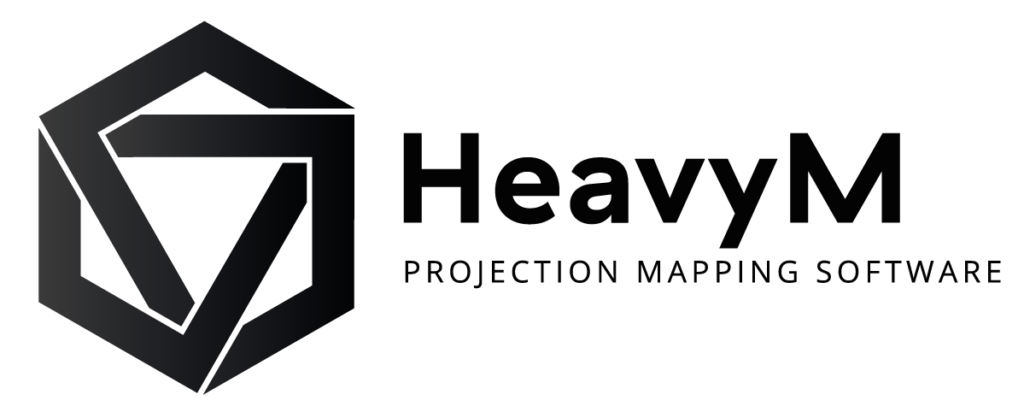New Media Art : What it is and How to Create It!
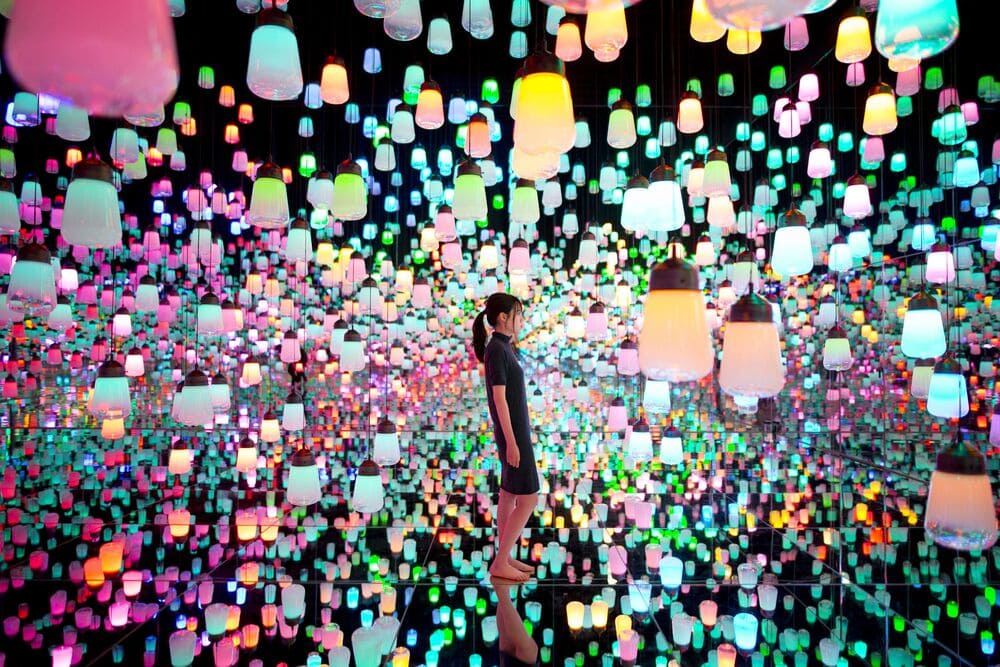
Throughout the years, art develops and keeps on evolving, just like any other practice. Artists and technology now push the boundaries of what is known and redefine what is possible further. Pencils and feather pens change to digital ones, and fingers can conceive the most gorgeous artworks without ever touching paint or paper. Digital technology shakes up artistic habits and the way we envision creativity. Basking in the use of new technologies, new media art drew a fresh breath in recent years. From that point on, let us try and establish what new media art is and discover how you can easily create some.
What Is New Media Art?
The term “new media art” refers to a wide range of contemporary artworks that include new technology such as computer animation, virtual reality, and the online world.
New media art is intrinsically tied to digital art and contemporary art, and may possibly be called a hybrid of the two. In fact, it encompasses all types of contemporary art created, edited, or broadcast by new media technology. This includes works created with computer animation, video games, robotics, biotechnology and 3D printing, as well as what falls under the types of digital art (such as interactive, internet and virtual arts). As the form continues to evolve and new media technologies are invented and explored by artists, new media art resists rigid classification.
The 4 Pillars of New Media Art
New media art is a broad concept that includes a large number of creative fields. Here are its four main pillars:
- Digital technologies: New media art essence takes its roots in digital technologies, such as computer graphics, artificial intelligence, or virtual reality.
- Multimedia: Blending several forms of media in one piece of art is the standard approach used by new media artists.
- Interactivity: New media artists genuinely mean to interact with their audience. Social media, virtual reality and video games are examples of digital media types that allow viewers to engage directly with the artwork.
- Digital culture: New media art is in essence part of the digital culture. It means to challenge how we interact online and how new media is progressively influencing our daily lives.
New Media art, nestled in Digital Art
New media art is intrinsically linked to digital art. In fact, digital art is an artistic work or practice that uses digital technology as part of the creative or presentation process. Therefore, it only differs from traditional art in the tools used to produce or distribute the creative content. Art, in a general sense, is not defined through the means wielded to achieve a piece, more so through the emotion, vision and message the artist can convey. For example, a painting canvas is a medium through which an artist may create art and deliver ideas and inspirations. In the same way, a computer is but a tool through which the artist can express his sense of line, form, color, composition and rhythm.
The creative elects mediums to tell the artistic stories she/he wants, whether oils, watercolors or pixels, and the notion of technology intervenes in the practice to enhance the media as well as to embellish, characterize and ascertain the message.
New Media Art’s History
As new technology advanced at a rapid rate in the mid-twentieth century, new media art began to appear around the same time. In fact, we even trace its origins back to the invention of the praxinoscope and moving photographic contraptions in 1877.
But it is when new technologies made their way into the realm of artistic creation that new media art really began to kick things into gear. Various types of kinetic and light art might be seen as forerunners of the future explosion of new media works from the 1920s through the 1950s.
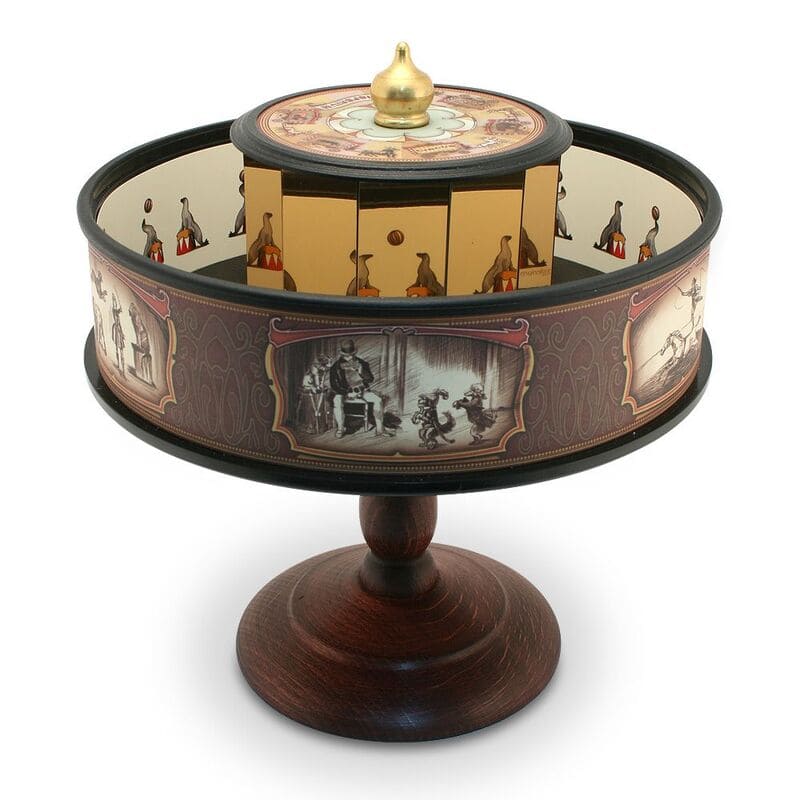
Later on, the Internet’s arrival in the 1990s saw an explosion of new media artworks and new media interconnections. As a genuine game-changer, the internet also offered a venue for new media artists to reach enormous previously untapped audiences.
Milestones:
- View From the Black Room: Wolf Vostell incorporated a television set in his View From the Black Room cycle in 1958. It expanded the concept of found object art into the domain of technology. This was one of the first times modern technology was combined with traditional artmaking methods.
- Robotics: Artists began experimenting with robots in the 1960s as a means of creating more kinetically active artworks. French artist Jean Tinguely was one of the first to employ this new technology, adding robotics into his self-destructive artwork Homage to New York, which was influenced by Fluxus and Dada (1960).
- The internet: The emergence of computer graphics and the internet in the 1990s greatly increased the possibilities of new media art. Websites, video games, and other types of digital graphics started to be used by many new media artists to create their work.
- Social media: The rise of social media technology in the twenty-first century has generated new means for artists to contact audiences. On the other hand, it created new opportunities for artists to criticise those same technologies.
New Media Art notable projects
This form of art would not be where it is today without the works of certain pioneers and creators. New media artists do indeed get more and more famous through the expansion of social media and NFTs. This next series of contemporary artworks shows examples of what paved the way as well as what is possible of doing.
Nam June Paik Electronic Superhighway
Nam June Paik is hailed by many as the father of video art. One of his most noted works is “Electronic Superhighway”, a term he made famous in the 1970s.
His artwork illustrates how he interpreted a diverse nation through media technology. The Electronic Superhighway is a large installation, constructed with 336 televisions, 50 VHS players, 3750 feet of cable, and 575 feet of multicolored neon tubing.
When visitors first see the Electronic Superhighway, they are completely taken aback. It is awe-inspiring because of the flood of audio and visual material, as well as the flashing neon lights. Concentrating on any state that the neon lights border or the video dialogues that play for each state proves difficult.
As a true pioneer, he recognized the potential for people from all parts of the world to collaborate via media. Moreover, he knew that media would completely transform our lives.
Rafaël Rozendaal, Into Time
Rozendaal’s Into Time work, in its original form, is to be experienced via Internet : intotime.com . The artwork fills the browser viewport with pulsing gradients. It is collaborative in the sense that the visitor’s participation is essential to the work’s completion. Visitors create their own compositions by clicking on the art, making it really interactive.
into time .com displays the artist’s fascination in the impact of the internet on the distribution and reception of art. The concept of an artwork as a unique item to be viewed in a certain time and place, as well as the value it receives from this condition, is challenged in browser-based artwork.
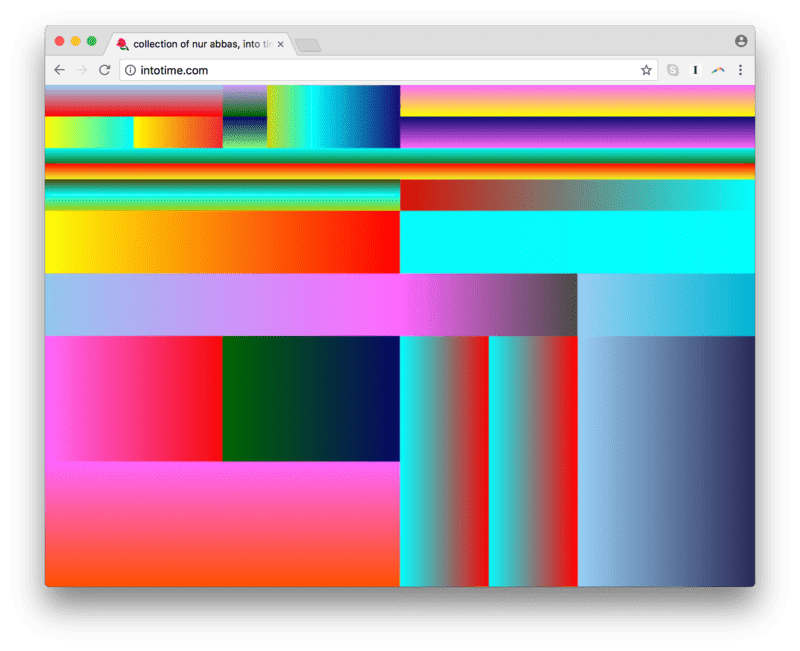
Rozendaal believes that his work may be adapted to a variety of media and circumstances. He incorporated time.com into real installations, such as this one in Brazil.
The work should also be adaptable to a variety of technical environments. Rather than simply recreating the work’s original setting, Rozendaal wants to make it possible for it to be moved to other formats as they become alive.
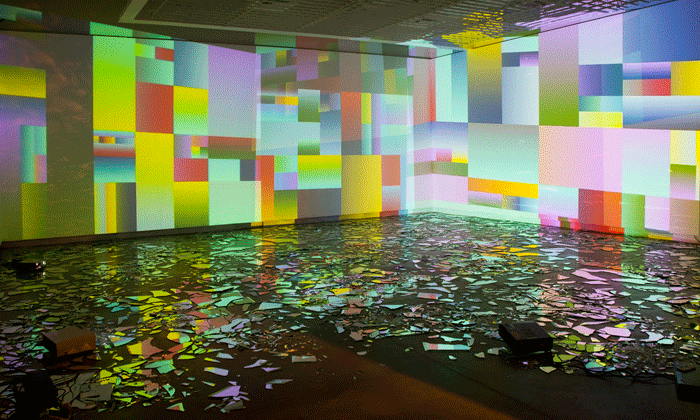
Mario Klingemann, Memories of Passersby I
Mario Klingemann is a pioneer in the field of neural networks, computer learning, and AI art. As is his project, Memories of Passersby I, a pioneering artwork of artificial intelligence.
Fully autonomous, it generates a never-ending stream of pictures using a complicated system of neural networks. The goal is to create unsettling views of male and female faces made by a computer. The AI computer is contained in a custom-made chestnut wood cabinet. It is connected to two framed screens, and the artwork is shown as an installation piece.
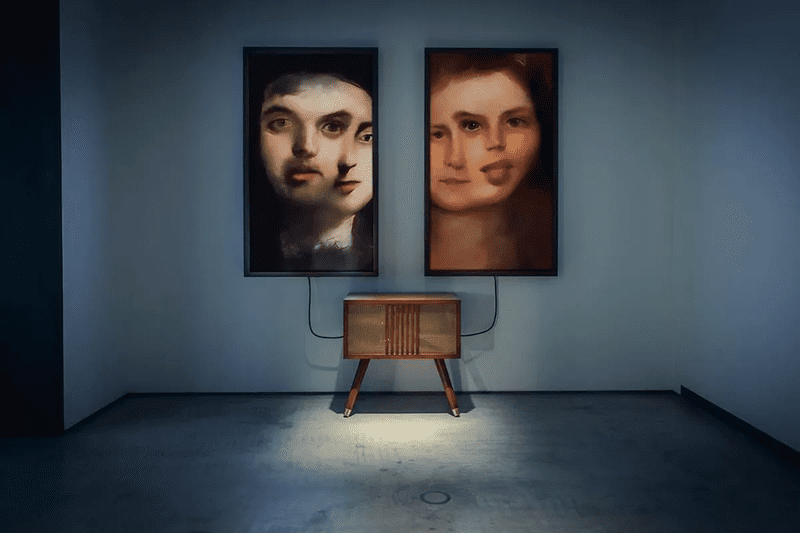
Memories of Passersby I, unlike other generative art works, does not include a database. Mario Klingemann created and trained an AI brain that makes entirely new portraits in real time, pixel by pixel. The artworks exhibited on the screen are unique, AI-generated artworks, not random or planned mixes of existing pictures.
Memories of Passersby I is a captivating experience for the spectator, allowing them to watch an AI brain “think” in real time. And at the same time, viewing really unique photographs that have never been seen before.
teamLab, Light Sculpture - Plane
If you have been on Instagram over the last several years, chances are you’ve seen some of teamLab’s installations. The collective’s work, which explores the increasingly irreconcilable connection between nature and artificial, is both playful and incredibly photogenic, combining immersive lighting with digital interactivity.
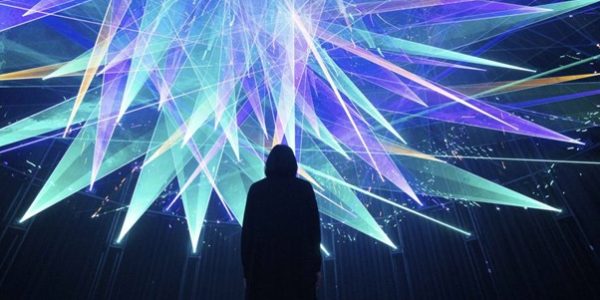
Nestled at the intersection of art, design and technology, most of teamLab’s virtual dream adventures are exhibited in specifically designed permanent installations in Tokyo, Macau, and Shanghai. Such is the case for the Light Sculpture Plane above and other projects.
Hito Steyerl: Actual Reality OS
The Serpentine Gallery in London has a brand-new new media art experience to offer. It was made by filmmaker, visual artist and writer Hito Steyerl. Visitors to the Serpentine are prompted to view an app that uses augmented reality to show what Hito Steyerl calls Actual RealityOS.
Actual RealityOS is an open source data visualization platform that combines augmented reality, immersive audio, and data collecting and mapping methodologies for mobile devices. The app takes into account the mutually beneficial link between technology and power. This link is clearest in the decision-making capacity embedded in technologies such as artificial intelligence and predictive modeling, which are being used to determine access to services such as insurance, housing, and social benefits.
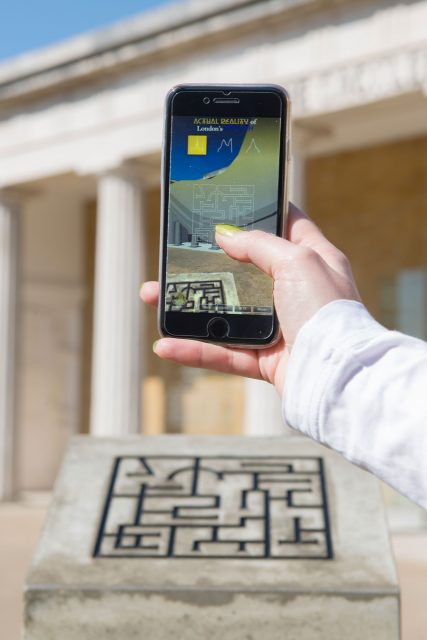
Projection Mapping as New Media Art
Now that we’ve seen examples of what new media art could be, let’s focus on one simple way to produce some : projection mapping. Projection mapping, in that regard, can serve as a medium and as a media, and falls naturally under new technologies and contemporary art. It therefore goes without saying that it is and can be used for new media art.
The beauty of projection mapping is that it can also serve purely as an artwork itself. In that case, the artist’s creative intent is conveyed through the mapping practice and the art piece can’t be whole without it. The practice of projection mapping as a new media art then takes on its full meaning, as technological means become the focal point of an artwork. That generally implies that the artist has considered and thought up creations that wouldn’t be possible through traditional art or, in other words, means that she/he is a new media artist.
Mastering this form of new media art is in your reach with the simplest to use and most user-friendly projection mapping software. In fact, HeavyM was designed for artists and thought up to enable creating immersive experiences. Thanks to real-time image generation, you can create your designs, and see them interact live with the world at the same time. You can bring the most complex and amazing ideas to life as the visual effects will light up the space with no rendering time to create epic shows.
Projection Mapping New Media Art Examples
Hacking Paris
In this elegant interactive new media art mapping experience, HeavyM “hacked” Paris’ City Hall.
The main goal is to emphasize a remarkable venue while also providing a digital animation to accent the occasion. As a result of projection mapping, the main staircase’s steps react to public passing by triggering video animations. The installation provides visitors with an immersive and memorable experience.
To detect the presence and position of individuals on the stairs, HeavyM employed a ZED stereoscopic camera and an image processing algorithm built specifically for the installation.
This information is sent to a shader, which is then displayed and deformed using HeavyM to turn on/off the stairs as the person walks by. Finally, as soon as someone enters the detecting field, a “glitter rain” movie is played.
Mercedes, New A-Class model
Mercedes tasked HeavyM with promoting their new A-Class car. Our team partnered with Mythologies agency to create an interactive experience using three projectors. Guests had to input their initial name, favorite music, and choose a destination from a list of five options before entering our video mapping-themed box. Their customised experience might begin once they enter. They were transported to another world for two minutes thanks to an intense and multi-sensory encounter.
Data.Flaw, PS5 Interactivity Artwork
Data Flaw used the concept of interactivity to include the viewer into his new media art piece at the Makerlab of the Paris Interdisciplinary Research Center. Both an aesthetic and a playful attitude are sought. The audience becomes an active participant in the work and becomes aware of the impact of their actions on the final product, which is exhibited as an interactive projection.
The joystick can be used to activate a variety of effects and sequences in HeavyM. It can, for example, use the joysticks to control the hue of the shapes and their colors. Beautiful live color combinations can be simply created by anyone. Hyper Light Drifter provided the inspiration for the color scheme and various gradients.
These were some types of new media art embellished through projection mapping. Such a trick is easy to accomplish if you have the right tools. With HeavyM, you can easily import any kind of media file whether it’s videos, photos or even webcam streams directly into the software and focus solely on your specialty to then create astonishing experiences. Simply define the area you want to project on thanks to HeavyM’s intuitive drawing and creative tools to easily adapt your mapping to the events where you perform.
Moreover, HeavyM is compatible with Syphon and Spout to exchange video streams between applications. Therefore, if you’re creating new media art through other content creation softwares such as Resolume or TouchDesigner, you will be able to modify and adjust your artwork in real time while it’s projected on the desired surface.
Conclusion
This was a peek into what new media art is. The advantage of technology is so that it can all be combined and crossed to create authentic and innovative creations. However, to cross a multitude of arts requires a certain level of mastery in the practices in question. Whether you have some or none, the art of projection mapping is within your grasp with the world’s simplest to use and most user friendly projection mapping software.
To be continued
Learn more about projectors
We have created a detailed guide to choosing the right projector for your needs. Discover our tips and mistakes to avoid in this guide that explains the different features step by step.
Explore the HeavyM software
HeavyM is a video mapping software that is capable of generating visual effects and projecting them on volumes, decorations or architectural elements. HeavyM is Mac and Windows compatible.

